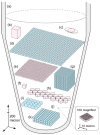Digital PCR: Endless Frontier of 'Divide and Conquer'
- PMID: 30400421
- PMCID: PMC6189721
- DOI: 10.3390/mi8080231
Digital PCR: Endless Frontier of 'Divide and Conquer'
Abstract
Digital polymerase chain reaction (PCR) is becoming ever more recognized amid the overwhelming revolution in DNA quantification, genomics, genetics, and diagnostics led by technologies such as next generation sequencing and studies at the single-cell level. The demand to quantify the amount of DNA and RNA has been driven to the molecular level and digital PCR, with its unprecedented quantification capability, is sure to shine in the coming era. Two decades ago, it emerged as a concept; yet one decade ago, integration with microfluidics invigorated this field. Today, many methods have come to public knowledge and applications surrounding digital PCR is mounting. However, to reach wider accessibility and better practicality, efforts are needed to tackle the remaining problems. This perspective looks back at several inspiring and influential digital PCR approaches in the past and tries to provide a futuristic picture of the trends of digital PCR technologies to come.
Keywords: digital polymerase chain reaction (PCR); emulsion droplet; microfluidics; microwell chip.
Conflict of interest statement
The authors declare no conflict of interest.
Figures


References
LinkOut - more resources
Full Text Sources
Other Literature Sources
Miscellaneous

